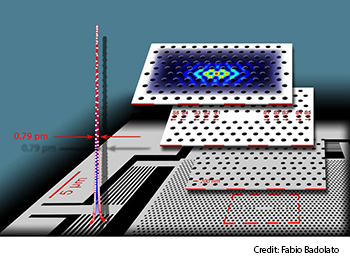
Left: The long trapping of light appears as a very narrow peak of the resonant mode. Top layer: The light-trapping nanostructure confines light in the tiny red regions. Second layer: The design mimics evolutionary biology. Bottom two layers: Electron micrographs of the realized L3 nanostructure in silicon.
A team of physicists at the University of Rochester (U.S.A), EPFL (Switzerland), and University of Pavia (Italy) has created an innovative light-trapping photonic crystal nanocavity (PCN) with one of the highest recorded quality factor per mode volume (Q/V) ratios ever in a very small footprint. The device holds promise for integrated photonic platforms and structures (Appl. Phys. Lett., DOI: 10.1063/1.4882860).
Professor Antonio Badolato at the University of Rochester and colleagues realized the nanostructure design through artificial intelligence codes inspired by genetics, improving the performance of a conventional L3-type PCN to approximately Qexp = 2 × 106, a 20× improvement over the highest previously reported Q on L3 PCNs. The corresponding Qexp/V value is more than 10 times larger than those previously reported in other L3 PCNs. Furthermore, the design reduces the footprint of the PCN while maintaining a high-volume fabrication capability.
Professor Vincenzo Savona and his team at EPFL developed a numerical approach that combines a genetic algorithm with a fast simulation technique, allowing for fast exploration of thousands of cavity designs to select the “fittest” one, that is, those that exhibit the optimal combination of parameters such as longest trapping time and highest quality factor. Using this approach, the team was able to trap light for nanoseconds in a nanostructured region of a silicon wafer measuring approximately 0.5 × 10-6 m.
The new nanocavity could enable nanophotonics platforms with ultra-dense integration and quantum state control. Such a platform would be promising for applications like label-free biosensing.
